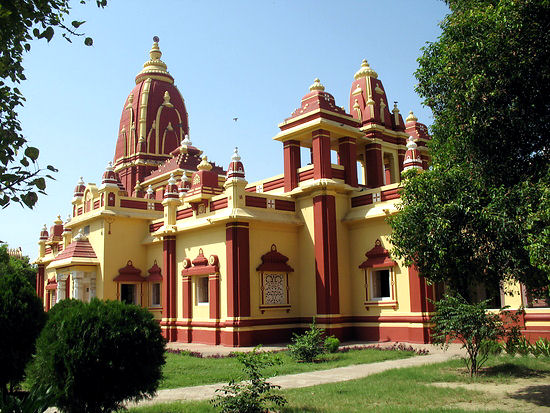

Phewa Lake:
Spreading majestically westwards from Pokhara, Phewa Lake is the second-largest lake in Nepal. On calm days, the mountains of the Annapurna Range are perfectly reflected in the mirrored surface of the tal. Away from the shore, the water is clean and deep and the dense forest along the south side of the lake provides shelter for brilliant white egrets. The best way to appreciate Phewa Lake is by rowboat, which can be hired for 350 NRS per hour.
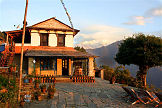 Dhampus Holiday Home: Dhampus village is a small settlement of Gurungs, one full days walk from Pokhara. Alternative one can take a taxi ride for 45 minutes from Pokhara and than start trekking for 2 hours to reach Dhampus Holiday Home. It offers spectacular mountain scenery and takes you north of Annapurna & Mt. Machhapuchhare (Fishtail) ranges. This region is heavily settled and farmed. Trekkers can have views of mountains from Dhaulagiri, and Annapurna, including the magnificent Mt. Machhapuchare (Fish Tail), Dhaulagiri, Lamjung Himal and many other peaks of Annapurna and Dhaulagiri Region.
Dhampus Holiday Home: Dhampus village is a small settlement of Gurungs, one full days walk from Pokhara. Alternative one can take a taxi ride for 45 minutes from Pokhara and than start trekking for 2 hours to reach Dhampus Holiday Home. It offers spectacular mountain scenery and takes you north of Annapurna & Mt. Machhapuchhare (Fishtail) ranges. This region is heavily settled and farmed. Trekkers can have views of mountains from Dhaulagiri, and Annapurna, including the magnificent Mt. Machhapuchare (Fish Tail), Dhaulagiri, Lamjung Himal and many other peaks of Annapurna and Dhaulagiri Region.
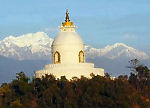 World Peace Pagoda: Balanced on a narrow ridge high above Phewa Tal, the brilliant-white World Peace Pagoda was constructed by Buddhist monks from the Japanese Nipponzan Myohoji organisation. There are three paths up to the pagoda and several small cafes once you arrive.
Hire a rowboat from Pokhara lakeside and let youeself ferry across the lake to the other side. From there you walk 1 hrs up the hill to the World Peace Pagoda, which affords breathtaking views over the Fewa Lake and the mountains beyond.
World Peace Pagoda: Balanced on a narrow ridge high above Phewa Tal, the brilliant-white World Peace Pagoda was constructed by Buddhist monks from the Japanese Nipponzan Myohoji organisation. There are three paths up to the pagoda and several small cafes once you arrive.
Hire a rowboat from Pokhara lakeside and let youeself ferry across the lake to the other side. From there you walk 1 hrs up the hill to the World Peace Pagoda, which affords breathtaking views over the Fewa Lake and the mountains beyond.
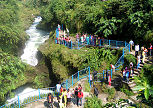 Devi's Falls: Locally known as Patale Chhango (Hell’s Fall), Devi’s fall (also known as David’s falls) is an awesome waterfall lying about 2 km south-west of Pokhara airport on the highway to Butwal (Tansen), just before the Tashi Ling Tibetan Village.
Devi's Falls: Locally known as Patale Chhango (Hell’s Fall), Devi’s fall (also known as David’s falls) is an awesome waterfall lying about 2 km south-west of Pokhara airport on the highway to Butwal (Tansen), just before the Tashi Ling Tibetan Village.
This is a breath taking view of Davis Fall in Chorrepatan. Chorrepatan is famous for this water fall and there is also a cave just two minutes walk from this fall. The water flowing in this fall comes from Fewa lake and the fall is worth visiting during the rainy seasons as it possesses its maximum velocity. Devi's Falls marks the point where the Pardi Khola River vanishes underground. When the stream is at full bore, the sound of the water plunging over the falls is deafening. An interesting legend says that a foreigner named David was skinny-dipping in the Pardi Khola (river) when the floodgates of the dam were opened, sweeping him into an underground passage beneath the fall, never to be seen again.
Varahi (Barahi) Temple:
Pokhara's most famous Hindu temple, the two-tiered pagoda-style Varahi (Barahi) Mandir. Founded in the 18th century, the temple is dedicated to Vishnu in his boar incarnation, but it's been extensively renovated over the years. Hire a rowboat from Pokhara Lakeside and paddle to the middle of the lake, to the island with the Varahi Mandir.
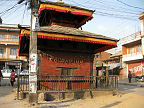 Bhimsen Temple: (भिमसेन मन्दिर) Bhimasena (one of the five Pandavas of the Mahabharata), the son of King Pandu.
The small two-tiered Bhimsen Temple, a two hundred-year-old shrine, is on the northern side of Pokhara, in the Old Pokhara section of the city, on the Bhairab Tole (road). The current structure is just two hundred years old, but the original temple is said to have been the oldest temple in Pokhara. The current pagoda-style mandir is just 18 ft. long, 12 ft. wide and about 24 ft. high.
Bhimsen Temple: (भिमसेन मन्दिर) Bhimasena (one of the five Pandavas of the Mahabharata), the son of King Pandu.
The small two-tiered Bhimsen Temple, a two hundred-year-old shrine, is on the northern side of Pokhara, in the Old Pokhara section of the city, on the Bhairab Tole (road). The current structure is just two hundred years old, but the original temple is said to have been the oldest temple in Pokhara. The current pagoda-style mandir is just 18 ft. long, 12 ft. wide and about 24 ft. high.
The main temple lintel is quite traditional, with a central image of Bhima holding his mace. He is flanked by smaller male and female figures, perhaps his consort and an attendant. On either side are two large makaras, (mythical crocodile) and above him is a beautiful Garuda. The Cult of Bhimasena.
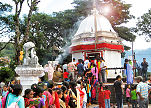 Bindhya Basini Temple: Bindhyabasini Temple is also one of the most popular and well known temple in Pokhara. Founded in the 17th century, the Bindhya Basini Temple is sacred to Durga, the warlike incarnation of Parvati, worshipped here in the form of a saligram (ammonite fossil). It is situated in the laps of Machhapuchhare and Annapurna ranges. This temple lies in the north of Pokhara .This temple is 3000 ft above from the sea level. You can get a fabulous view of Pokhara city and the Himalayas from this temple.The fragrance of the scented “Dhup” and refreshing air can keep anyone spellbound. Just at the opposite side of the Bindabasini Temple, there is another temple called Krishna Mandir where the annual birthday of Lord Krishna is celebrated on the day called Krishna Janmastami.
Bindhya Basini Temple: Bindhyabasini Temple is also one of the most popular and well known temple in Pokhara. Founded in the 17th century, the Bindhya Basini Temple is sacred to Durga, the warlike incarnation of Parvati, worshipped here in the form of a saligram (ammonite fossil). It is situated in the laps of Machhapuchhare and Annapurna ranges. This temple lies in the north of Pokhara .This temple is 3000 ft above from the sea level. You can get a fabulous view of Pokhara city and the Himalayas from this temple.The fragrance of the scented “Dhup” and refreshing air can keep anyone spellbound. Just at the opposite side of the Bindabasini Temple, there is another temple called Krishna Mandir where the annual birthday of Lord Krishna is celebrated on the day called Krishna Janmastami.

Radha Krishna Mandir, Pokhara:
As the name indicates, the Radha Krishna Mandir is dedicated to Lord Krishna,
just at
the opposite side of the Bindabasini Temple.
Sita-Rama Temple in Janakpur: Janakpur, (जनकपुर) also known as Janakpur-dham, the birth place of Sita Devi, is one of the historical and religious cities of Nepal. The Deities of Sita, Rama and Laksman are worshipped here. The city is located about 123 km south-east of Kathmandu, 20 km from the Indian border. The most important historical reference to Janakpur is in the Hindu epic Ramayana, where Lord Rama's wife Sita Devi (also called Janaki) is said to have been the princess of Videha. Her father, King Janak, found baby Sita in a furrow of a field and raised her as his daughter. When she grew up, the king announced that she should be wed by whoever was able to string the divine bow of Shiva. Though many royal suitors tried, Lord Rama, prince of Ayodhya, alone could even lift the bow. As Rama and Sita are major figures in Hinduism, Janakpur is an important pilgrimage site for Hindus.
Gita Mandir is located at Birgunj. The Temple is called Gita Mandir because here you can learn all about the Holy Mahabharat and the great epic Bhagavad-gita, which was spoken 5000 years ago be Lord Sri Krishna to Arjuna.
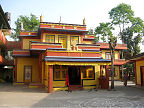 Tibetan Village: There are the two Tibetan villages in the vicinity of Pokhara. One of them called Tashi Ling is in the south past patale chhango. The other village by the name of Tashi Palkhel lies north of Pokhara at a place called Hyanja on Pokhara Baglung Highway. The Tibetan people living in these villages keep themselves busy by producing and trading in woolen carpets and other handicraft items. They also run souvenir shops around lakeside. Some of them work like hawkers selling souvenirs at bargaining prices.
Tibetan Village: There are the two Tibetan villages in the vicinity of Pokhara. One of them called Tashi Ling is in the south past patale chhango. The other village by the name of Tashi Palkhel lies north of Pokhara at a place called Hyanja on Pokhara Baglung Highway. The Tibetan people living in these villages keep themselves busy by producing and trading in woolen carpets and other handicraft items. They also run souvenir shops around lakeside. Some of them work like hawkers selling souvenirs at bargaining prices.
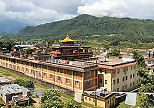 Tashi Palkhel: The largest Tibetan settlement is Tashi Palkhel, a few kilometres north of Pokhara on the road to Baglung. The colourful Jangchub Choeling Gompa in the middle of the village is home to around 100 monks and masked dances are held here in January/February as part of the annual Losar (Tibetan New Year) celebrations. To reach the gompa you have to run the gauntlet past an arcade of persistent handicraft vendors.
Nearby is a chörten piled with carved mani stones bearing Buddhist mantras and a carpet weaving centre, where you can see all stages of the process and buy the finished article.
Tashi Palkhel: The largest Tibetan settlement is Tashi Palkhel, a few kilometres north of Pokhara on the road to Baglung. The colourful Jangchub Choeling Gompa in the middle of the village is home to around 100 monks and masked dances are held here in January/February as part of the annual Losar (Tibetan New Year) celebrations. To reach the gompa you have to run the gauntlet past an arcade of persistent handicraft vendors.
Nearby is a chörten piled with carved mani stones bearing Buddhist mantras and a carpet weaving centre, where you can see all stages of the process and buy the finished article.
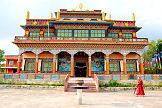 Karma Dubgyu Chokhorling Monastery:
Karma Dubgyu Chokhorling Monastery:
Overlooking Pokhara on the east side of the Seti River, the huge Karma Dubgyu Chokhorling Monastery is worth visiting just for the views. The main prayer hall has a gilded statue of Sakyamuni (the historical Buddha) and there are more Buddhist statues in the monastery gardens.
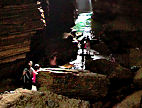 Gupteshwor Mahadev Cave: Just across the road from Devi’s Falls, is perhaps the slightly less famous, but equally stunning Gupteshwor Mahadev cave, which contains a huge stalagmite worshiped as a Shiva lingam. A testament to the statement that locals like to keep noting, ‘Pokhara is hollow’; Gupteshwor is a 3 km long porous cavern underneath the main road of Chorepatan. Divided into halves, the first half of the cave has a temple dedicated to Lord Shiva or Mahadev, some 40 meters from entrance. A recent addition is an artificial divide in the left corner where a life size replica of a cow-Mahadev’s faithful ride-resides. You can pay a small fee to the Pujari there, who will then hand you a marble which when inserted into the slot on the cow’s back, performs a little miracle. The cow’s udder starts leaking milk, all cleverly orchestrated for the devotees. Taking pictures and videos in this first half are strictly prohibited.
Gupteshwor Mahadev Cave: Just across the road from Devi’s Falls, is perhaps the slightly less famous, but equally stunning Gupteshwor Mahadev cave, which contains a huge stalagmite worshiped as a Shiva lingam. A testament to the statement that locals like to keep noting, ‘Pokhara is hollow’; Gupteshwor is a 3 km long porous cavern underneath the main road of Chorepatan. Divided into halves, the first half of the cave has a temple dedicated to Lord Shiva or Mahadev, some 40 meters from entrance. A recent addition is an artificial divide in the left corner where a life size replica of a cow-Mahadev’s faithful ride-resides. You can pay a small fee to the Pujari there, who will then hand you a marble which when inserted into the slot on the cow’s back, performs a little miracle. The cow’s udder starts leaking milk, all cleverly orchestrated for the devotees. Taking pictures and videos in this first half are strictly prohibited.
For an extra charge on top of the entrance fee, you can gain entree to the other half which is about 100 meters long ending with the spectacular view of the bottom half of Devi’s Falls; water gushing through the jagged edges and disappearing underground. The second entrance is narrow and wet, a long tunnel that suddenly gives way to an open cavity with a viewing platform, from where you can enjoy the view of the waterfall at a safe distance. If you prefer, you can climb down all the way to the bottom for an up close encounter. Opening hours are from 6 to 6.
Sarangkot: Sarangkot is famous for the overwhelming views of the Himalaya range. The breath taking view of the Annapurna Himalaya from Sarangkot is almost a religious experience. From here, you can see a panoramic sweep of Himalayan peaks, from Dhaulagiri (8167m) in the west to the perfect pyramid of Machhapuchhare (6997m) and the rounded peak of Annapurna II (7937m) in the east. At dawn and dusk, the sun picks out the peaks in brilliant colours. The main village is just below the ridge, but a set of concrete steps leads uphill to a dramatic viewpoint in the ruins of an ancient kot (hill-fort). The fort is currently occupied by the Nepali army, but photography is fine, as long as you don't take pictures of the soldiers. There's another ruined fort at Kaskikot. Sarangkot is also the launching spot for paragliders, so instead of having to drive up the mountain in the morning, by staying in Sarangkot it's possible to get an early start.
Sunrise Paragliding: Paragliding in Nepal amongst the grandest scenery on earth is an inspiring experience. Float over mystery shrouded monasteries, ancient places, beautiful turqoise lakes, raging Himalayan rivers, exotic jungles and villages forgotten by time. For adventure seeker paragliding in Pokahra can be a truly wonderful and fulfilling experience. Paragliding from the top of Sarangkot must be one of the most exciting experiences in the Himalaya. Sunrise Paragliding offers 30-minute flights exploring the thermals above Sarangkot (US$75) and one-hour cross-country jumps across the valley north towards Annapurna (US$120). Another operator for Paragliding is Blue Sky Paragliding. Paragliding is a weather dependent sport and the flying season in Nepal commences from November through February, the best months being November and December. The take off points for these flights is Sarangkot (1592m), which offers prime views of Phewa Tal and the mountains at sunrise and sunset (provided the skies are clear);landing is by the lake. No previous experience is required as qualified pilots provide a short briefing before launching.
Seti River: The glacial river Seti, flows right through the heart of the Pokhara valley and goes completely underground at certain places. The Seti River is also called white Gandaki because of the limestones sediments that give the water a milky tint. This river cuts the deepest gorge in Nepal. The roaring Seti River passes right through Pokhara, but you won't see it unless you go looking. The river has carved a deep, narrow gorge through the middle of town, turning the water milky white in the process. At points, the gorge is less than a metre across and the river gushes by more than 50m below street level. The best place to catch a glimpse of the Seti River is the park just north of Old Pokhara near the Gurkha Museum or the KI Singh Bridge, on the road to Batulechaur. If you peer down through the darkness, you can just see the water churning through the gorge. Nearby is a small Buddhist gompa with friendly novice monks.
Gurkha Museum: Situated just north of Mahendra Pul, near the KI Singh Bridge, this well-curated museum displays the achievements of the famous Gurkha regiment. Accompanied by sound effects of machine-gun fire, it covers Gurkha history from the 19th-century Indian Mutiny, through two World Wars to current-day Afghanistan. There is a fascinating display outlining the stories of the 13 Gurkhas who’ve been awarded the Victoria Cross medal.
Jungle Safari: Jungle safari can be experience at Chitwan National Park, One of the well fascilated National Park in the Nation with just 5 Hours Drive from the valley. A safari in Nepal is a fun filled package ideal for anyone. The national parks offer a range of accommodations form lush resorts to basic tent style. The resorts make a package for you that included everything from you sleeping arrangements to meals to days full of activity.
